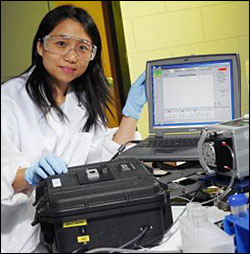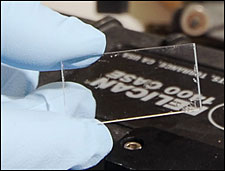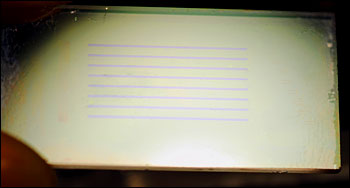
Bird Flu Biosensor is Better
ATLANTA, Sept. 28, 2007 -- A new, portable biosensor based on interferometry is more sensitive and days faster than commercially available tests for avian influenza ("bird flu"), and can also identify different strains simultaneously.
“We can do real-time monitoring of avian influenza infections on the farm, in live-bird markets or in poultry processing facilities,” said Jie Xu, a research scientist in the Georgia Tech Research Institute’s (GTRI) Electro-Optical Systems Laboratory.

Jie Xu, a research scientist in the Georgia Tech Research Institute’s Electro-Optical Systems Laboratory, tests a sample using the optical waveguide sensor. (Georgia Tech photos by Gary Meek)
There are many strains of avian influenza virus worldwide that cause varying degrees of clinical symptoms and illness. In the US, outbreaks of the disease -- primarily spread by migratory aquatic birds -- have plagued the poultry industry for decades with millions of dollars in losses. The only way to stop the spread of the disease is to destroy all poultry that may have been exposed to the virus.
A virulent strain of avian influenza (H5N1) has begun to threaten not only birds but humans, with more than 300 infections and 200 deaths reported to the World Health Organization since 2003. Looming is the threat of a pandemic, such as the 1918 Spanish flu that killed about 40 million people, health officials say.
“With so many different virus subtypes, our biosensor’s ability to detect multiple strains of avian influenza at the same time is critical,” Xu said.
To test the biosensor, the researchers assessed its ability to detect two avian influenza strains that previously infected poultry. The results showed that it could detect a solution containing very few virus particles.
Xu tested a third strain of the virus as a control. When the sensor coating was modified to collect only the other two strains, the control strain was not detected even at high concentrations.
“The technology that Georgia Tech developed with our help has many advantages over commercially available tests -- improved sensitivity, rapid testing and the ability to identify different strains of the influenza virus simultaneously,” said David Suarez, a collaborator on the project and research leader of exotic and emerging avian viral diseases in ARS’ Southeast Poultry Research Laboratory in Athens, Ga. Suarez is providing antibodies and test samples for GTRI’s research.
The biosensor is coated with antibodies specifically designed to capture a protein located on the surface of the viral particle. For this study, the researchers evaluated the sensitivity of three unique antibodies to detect avian influenza virus.
The sensor utilizes interferometry -- the interference of light waves -- to precisely determine how many virus particles attach to the sensor’s surface. Light from a laser diode is coupled into an optical waveguide through a grating and travels under one sensing channel and one reference channel.

Jie Xu holds the optical waveguide sensor that could detect avian influenza on poultry farms.
Researchers coat the sensing channel with the specific antibodies and coat the reference channel with nonspecific antibodies. Having the reference channel minimizes the impact of nonspecific interactions, as well as changes in temperature, pH and mechanical motion. Nonspecific binding should occur equally to both the test and reference channels and not affect the test results.
An electromagnetic field associated with the light beams extends above the waveguides and is very sensitive to the changes caused by antibody-antigen interactions on the waveguide surface. When a liquid sample passes over the waveguides, any binding that occurs on the top of a waveguide because of viral particle attachment causes water molecules to be displaced. This causes a change in the velocity of the light traveling through the waveguide.
At the end of the waveguide, the light beams from the sensing and reference channels are combined to create an interference pattern. The pattern of alternating dark and light vertical stripes, or fringes, is imaged on a simple detector. By doing a mathematical Fourier transform, the researchers determine the degree to which the fringe patterns are in or out of step with each other, known as phase shift. This phase shift tells the amount of virus bound to the surface.
“The fringe pattern doesn’t look like it changes in the image, but with math we find out the speed of the light in the test channel changed creating this phase change,” said Xu.
Current methods of identifying infected birds include virus isolation, real-time reverse transcriptase polymerase chain reaction (RRT-PCR) and antigen capture immunoassays. Virus isolation is a sensitive technique, but typically requires five to seven days for testing. RRT-PCR is commonly available in veterinary diagnostic laboratories, but requires expensive equipment and appropriate laboratory facilities. RT-PCR can take as little as three hours to get test results, but routine surveillance samples are more often processed in 24 hours. The antigen capture immunoassays can provide rapid test results, but suffer from low sensitivity and high cost.

Close-up view of the optical biosensor, which is approximately 16 mm x 33 mm in size. The horizontal purple lines are the channels on the waveguide.
Beyond the waveguide sensor, the only additional external components required for field-testing with the biosensor include a sample-delivery device (peristaltic pump), a data collection laptop computer and a swab taken from a potentially infected bird. Power is supplied by a nine-volt battery and USB connection. The waveguides can be cleaned and reused dozens of times, decreasing the per-test cost of the chip fabrication.
Xu and Suarez are currently working together to test new unique antibodies with the biosensor and to test different strains. In addition, Xu is reducing the size of the prototype device to be about the size of a lunchbox and making the computer analysis software more user-friendly so that it can be field-tested in two years.
“We are continuing our collaboration and have provided additional money to Georgia Tech to move the project along faster,” said Suarez. “Since this technology is already set up so that you can use multiple antibodies to detect different influenza subtypes, we are going to extend the work to include the H5 subtype.”
In addition to Xu and Suarez, the research team included David Gottfried, who is now a senior research scientist in Georgia Tech’s Microelectronics Research Center.
Results of this study were published online in August in the journal Analytical and Bioanalytical Chemistry and will be included in journal’s Oct. 16 print edition. The work was funded by the US Department of Agriculture’s Agricultural Research Service (ARS) and the Georgia Research Alliance.
For more information, visit: www.gtri.gatech.edu
Published: September 2007